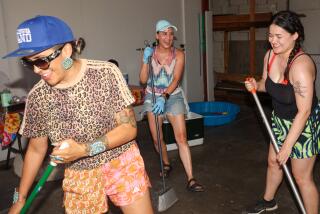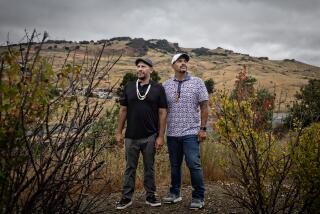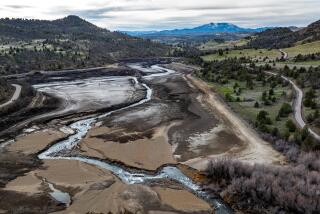A Tribute to Storytelling and Tradition
- Share via
FULLERTON — Orville Little Owl beat an elk-hide drum as he joined the other Iron Bull Singers at Cal State Fullerton on Saturday to tell musical tales of hunting expeditions and battles, some ancient and others more recent.
A member of the Mandan-Hunkpapa Lakota tribe, Little Owl learned the songs of his elders when he was a child on a North Dakota reservation. The Vietnam War veteran said he also weaves his own experiences into his music.
“I’ve been singing since I was 6 years old,” he said. “The songs are traditional word songs that are like an opera, telling a story. We tell about people we fought against. We fought in all the wars.”
He was one of 50 participants from two dozen tribes who gathered for the university’s third annual powwow. Organized by the Inter-Tribal Student Council at Cal State Fullerton, the event drew more than 1,000 observers this year.
For Native Americans, such inter-tribal events serve two purposes, organizers said: to keep their heritage alive and to educate the general public.
“The common misunderstanding is that tradition never changes,” said Chris Sandoval, a member of the student group. “We’re not stuck in one place in time.”
But Native American tribes are evolving minority groups, said Sandoval, a member of Orange County’s indigenous Acjachemen Nation Juaneno Band of Mission Indians. “We’re not gone, we’re not dead, and we’re not just in the movies.”
A powwow, which typically lasts three days and nights, is held nearly every weekend somewhere in the nation, participants said. Many singers and dancers travel the circuit with their families. Fullerton’s powwow is relatively small and lasts only one day.
Besides performances, powwows usually include vendor booths that offer a variety of handcrafted items such as pipes and turquoise-and-silver jewelry, as well as feathers, furs and T-shirts.
“The vendors add a nice touch and draw the public in,” said Ron Stray Wolf Knighton, a Fullerton resident who grew up on a Cherokee reservation in New Jersey. “They learn that we are not pagans and heathens.”
The dancing arena, Knighton explained, is blessed by an elder before the powwow begins, making it a spiritual place. “We dance for our forefathers, our hunters and warriors,” he said. “It’s a religious experience for most of us.”
Knighton, dressed in a brightly colored costume typical of Southeastern tribes, had painted his face white with a black band across his eyes and down his right cheek.
The face paint he said, symbolizes the Trail of Tears--the forced march of 17,000 Cherokees in the winter of 1838-39 from their ancestral home in Georgia to what is now Oklahoma. Thousands died on the trail.
Other participants said they discovered their heritage at powwows.
“I was lost for a long time. I felt something missing,” said Eddie Hummingbird, a Long Beach resident and member of the Cherokee tribe. He attended his first powwow seven years ago, he said, and is now a performer with the Wildhorse Singers of San Pedro.
A single father, he hopes his two daughters, who are learning the traditional dances, will have a sense of belonging. “I am trying to give them their culture,” he said. “I never had any when I was growing up.”
More to Read
Sign up for The Wild
We’ll help you find the best places to hike, bike and run, as well as the perfect silent spots for meditation and yoga.
You may occasionally receive promotional content from the Los Angeles Times.






